Trees Birds Mammals Fish Amphibians Reptiles
Wild Algarve
Bookshop
Chlorociboria aeruginascens (Nyl.) Kanouse ex C S Ramamurthi, R P Korf & L R Batra - Green Elfcup
Phylum: Ascomycota - Class: Leotiomycetes - Order: Helotiales - Family: Insertae sedis (placement uncertain)
Distribution - Taxonomic History - Etymology - Identification - Reference Sources
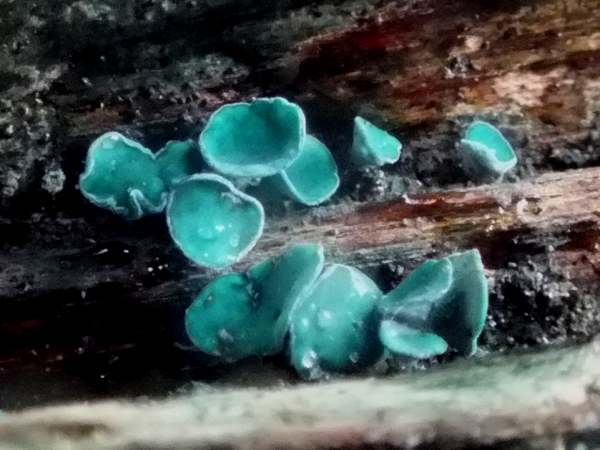
The green-stained wood that is evidence of Green Elfcup, Chlorociboria
aeruginascens, is a common sight, but the fruitbodies are seen only
infrequently. This mainly winter-fruiting fungus is sometimes referred to as Green Cup fungus.
Wood infected with Chlorociboria fungi has long been used in such decorative woodworking as Tunbridgeware. In Italy the practice dates at least to the 14th century, when it was used in 'intarsia', an inlaying process similar to marquetry.
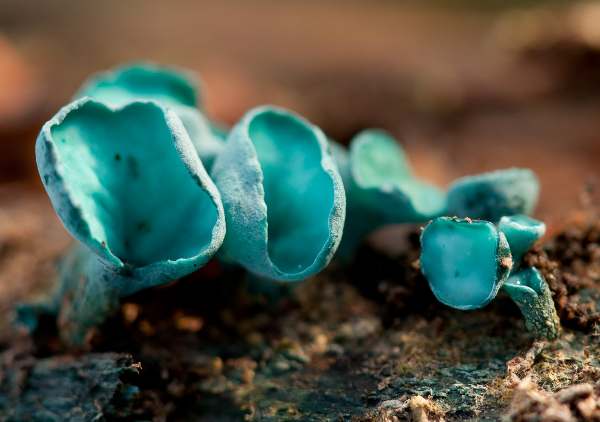
Distribution
In Britain and Ireland Chlorciboria aeruginascens is one of just two species recorded in the genus Chlorociboria, the other being Chlorociboria aeruginosa. Both result in green staining. Although C. aeruginosa tends to be a little smaller and very much rarer than C. aeruginascens, the fruitbodies of the two species cannot be confidently differentiated on macroscopic characteristics, but at 5-7 x 1-2µm the spores of Chlorciboria aeruginascens are significantly smaller than those of Chlorciboria aeruginosa (9-14 x 2- 4µm).
Both species are more often seen in the form of green-stained wood than when producing fruitbodies.
This ascomycetous fungus has a very wide geographical distribution that includes Europe and North America.
Taxonomic history
Described in 1869 by Finnish mycologist William Nylander (1822 - 1899), and given the scientific name Peziza aeruginascens, this ascomycetous species was transferred to the genus Chlorociboria in 1957 by American mycologists C S Ramamurthi, R P Korf, and L R Batra.
Synonyms of Chlorociboria aeruginascens include Helvella aeruginosa Oeder ex With., Chlorosplenium aeruginosum (Oeder ex With.) De Not., Peziza aeruginascens Nyl., and Chlorosplenium aeruginascens (Nyl.) P. Karst.
Etymology
The specific epithet aeruginascens comes from Latin and means 'becoming blue-green', which is what happens to wood that becomes infected with this fungus.
Identification guide
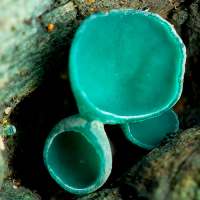 |
Fruitbody
Initially shaped like a goblet with a very
short stem that is usually central or slightly off centre, the fruitbodies flatten with age and develop wavy edges.
Individual fruit bodies are 0.5 to 1cm in diameter and usually less than
1cm tall.
The upper, fertile surface is bright green and smooth, while the
underside of the cup and the stipe are felty and pale blue-green,
darkening with age. |
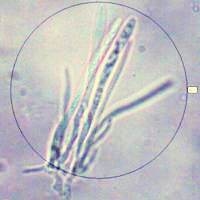 |
Asci
Eight-spored; typically 65 x 5µm.
Paraphyses
Narrow, clavate. (Paraphyses are structures of sterile tissue between the asci on the hymenial surface.)
|
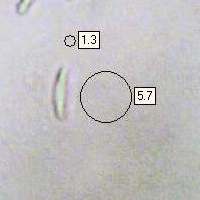 |
Spores
Fusiform, smooth, 5-7 x 1-2µm, with oil droplets visible at either end.
Spore print |
Odour/taste |
Not distinctive. |
Habitat & Ecological role |
Saprobic, on bark-free dead wood, particularly oak,
beech and hazel. |
Season |
The green stain is visible all the year
round, but fruitbodies occur infrequently and mainly in autumn. |
Similar species |
Chlorociboria aeruginosa is very similar and can only be separated with confidence by microscopic examination of spore dimensions.
Several darker cup-like ascomycetes fungi, including Bulgaria inquinans, occur in similar
habitats. |
Reference Sources
Fascinated by Fungi, 2nd Edition, Pat O'Reilly 2016, reprinted by Coch-y-bonddu Books in 2022.
-
Ramamurthi, C.S., Korf, R.P. & Batra, L.R. (1957). A revision of the North American species of Chlorociboria (Scerotiniaceae). Mycologia 49: 854-863.
-
Seaver, F.J. (1936). Photographs and Descriptions of Cup-Fungi: XXIV. Chlorociboria. Mycologia 28(4): 390-39
-
Dennis, R.W.G. (1981). British Ascomycetes; Lubrecht & Cramer; ISBN: 3768205525.
Breitenbach, J. & Kränzlin, F. (1984). Fungi of Switzerland. Volume 1: Ascomycetes. Verlag Mykologia: Luzern, Switzerland.
Medardi, G. (2006). Ascomiceti d'Italia. Centro Studi Micologici: Trento.
Dictionary of the Fungi; Paul M. Kirk, Paul F. Cannon, David W. Minter and J. A. Stalpers; CABI, 2008
Taxonomic history and synonym information on these pages is drawn from many sources but in particular from the British Mycological Society's GB Checklist of Fungi.
Acknowledgements
This page includes pictures kindly contributed by David Kelly.
Top of page...
Fascinated by Fungi. Back by popular demand, Pat O'Reilly's best-selling 450-page hardback book is available now. The latest second edition was republished with a sparkling new cover design in September 2022 by Coch-y-Bonddu Books. Full details and copies are available from the publisher's online bookshop...